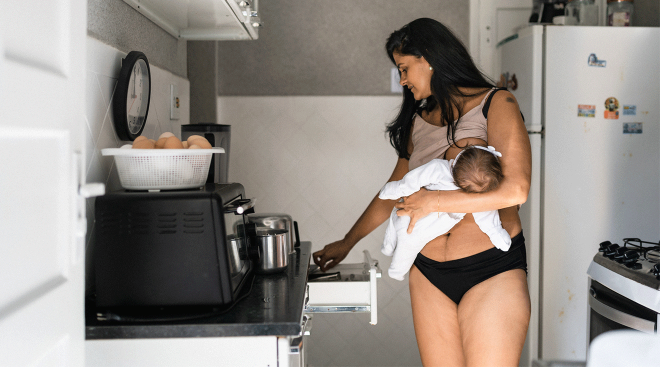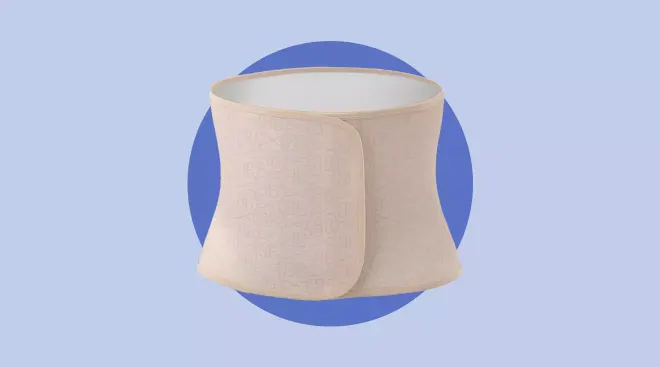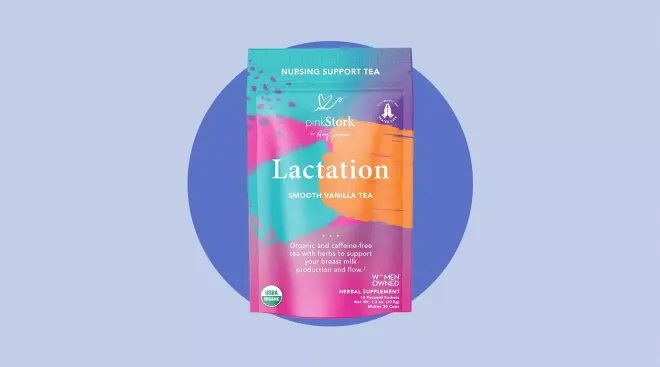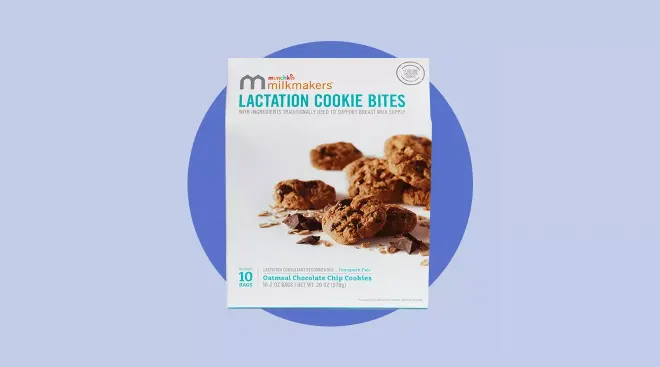The Fourth Trimester: How Baby Adjusts to Life Outside the Womb
If your baby could text you from the womb with just one request, it would likely be, “Please don’t evict me!” We all know that at roughly 40 weeks old, babies aren’t developmentally ready to thrive in the outside world without a lot of hands-on help. In fact, humans are born with the least-developed brains of any primate—researchers estimate that an additional nine to 12 months in utero would be required to bring humans up to neurological and cognitive speed with our monkey cousins.
Blame it on evolution: One theory says that women’s pelvises narrowed when we evolved to stand up on two legs. The new, tighter pelvis, necessary to support our bodies as we walked upright, made it dangerous and harder to birth our large-headed babes at most points past 42 weeks.
So what does this mean for you and your newborn? Brace yourself. For the first three months after birth—often dubbed the fourth trimester—you’ve got your work cut out for you as your baby matures and learns to cope with, well, everything.
The concept of the fourth trimester—the three-month period of adjustment for babies to life outside of the womb—was introduced in the late 1970s and then popularized by pediatrician Harvey Karp when he published The Happiest Baby on the Block in 2002. Karp’s work, which emphasizes the fact that we should think of our newborns as fetuses outside the womb, has helped thousands of sleep-deprived parents to soothe fussy infants. His method, dubbed the 5 S’s, helps caregivers mimic certain aspects of the womb, recreating the sounds, movement and snugness familiar to newborns as they learn to regulate their reflexes and refine their senses.
“The first three months involves lots of cuddling and extra care,” Ana Hernandez-Puga, MD, a pediatrician with TopLine MD Health Alliance in Kendall, FL, says. “It’s a huge learning curve for both the baby and parents.”
Think of it this way: For nine months, baby’s been used to a warm, noisy, comfortable place where they can move as you move. It’s a shock to be immediately moved into a cold, quiet nursery with and confined to a crib.
“We expect them to like this new situation right away,” Hernandez-Puga says. “Lack of sleep and nerves puts everyone at wits end.”
Every newborn is different, equipped with his own temperament that impacts how they deal with each step of maturation. Some babies are born mellow, and are easy to soothe with movements that come naturally mothers; others, not so much. According to Karp’s The Happiest Baby Guide to Great Sleep, babies emerge with four abilities that, for the first few weeks, “pretty much restrict a baby’s activities to eating, looking, sleeping, peeing and pooping,” he writes.
- Life support controls. Baby’s most innate actions, like heart rate, breathing, etc.
- State control. Baby’s level of alertness; learning to control this, writes Karp, is one of his brain’s first big jobs.
- Reflexes. Inherent instincts that help baby to do things like suck, sneeze and cry.
- Muscle control. Baby’s attempts at touching, looking and interacting are very tiny at first.
The stimulation your newborn receives from your eye contact, talking and touching helps his brain cells develop at an incredible rate. While they can see, hear and feel from birth, baby’s vision is blurry. They’ll learn to identify their mother first from her scent.
Crying is how babies communicate best, and you can expect lots of it. “You can never spoil a baby in these first few months—in fact, the more promptly and consistently you comfort your baby’s fussing in the first six months, the less demanding the baby is likely to be when they’re is older,” Hernandez-Puga says.
After a few weeks, you’ll eventually notice baby sleeping for longer stretches of time—though it takes some time for them to learn to sleep longer at night—feeding more regularly as their stomachs grow, and interacting with you more by cooing and gurgling for longer periods of alertness. And soon after, real interaction. “By 2, 3, months of age, your baby has changed dramatically from being a fetus to being able to do the most important thing a person can do: develop a dance of back-and-forth reciprocity—you smile, I smile, you smile back,” Karp tells The Bump.
Even if baby is easygoing, expect some fussiness, especially in the first couple of weeks. Checking for hunger (most babies eat roughly every two hours), dirty diapers, the need to burp should be your regular routine. If baby is otherwise well and becomes excessively fussy, you may have to get creative.
- Skin to skin. Holding your baby close and upright, with both of you wrapped in a blanket if it’s cold, helps soothe baby by getting them close to your heartbeat, your scent and your warmth.
- Motion. Walking, dancing, placing baby in a swing or even a trip in the car can help them relax.
- A warm bath. Warm water can be relaxing for some babies and might help you establish a bedtime routine.
If these don’t work, baby may be overstimulated, gassy, overtired or a combination of all three. Trying out Karp’s 5 S’s could bring your baby closer to sleep:
- Swaddle. Snugly wrapping baby like a burrito—arms in—recreates the security of the womb and helps to squelch baby’s startle reflex, which can jerk them awake.
- Side/Stomach. Holding baby on their side or stomach on your lap—or up over your shoulder—might help them feel more content. Use this for soothing only; when putting baby to sleep, always place them on their back to reduce the risk of SIDS.
- Shushing. Start by making shushing noises into baby’s ear that are as loud as baby’s cry, which might be reminiscent of noises they heard in the womb—the whooshing of blood pulsating by. Gradually lower your decibel as baby relaxes.
- Swinging. Supporting baby’s head, jiggle them quickly back and forth in tiny movements, moving no more than an inch or so in any direction.
- Sucking. Once nursing with baby is well established, offer them a pacifier to suck between feedings, or to soothe while they’re falling asleep.
“Twenty years ago, people were worried about spoiling their babies, giving their babies too much attention,” Karp says. “We’ve moved the ball down the field in terms of helping parents understand that their babies need closeness and responsiveness, which builds secure attachments.”
Mothering a newborn is tiring. Karp notes that mothers average about 6.5 hours of sleep a day, “which sounds okay until you realize it’s broken up into 20 little pieces—you never get more than an hour in a row,” he says. “Studies show that [this state of sleep deprivation] is the equivalent of being drunk.”
Sleep deprivation can lead to postpartum depression, marital distress and even SIDS, if you’re so tired that you inadvertently allow your baby to fall asleep with you in bed. To help parents get more sleep, Karp launched his own product, a bassinet called SNOO Smart Sleeper, that will rock your baby on cue and soothe them with white noise during naps and nighttime.
Kimberly Ann Johnson, author of The Fourth Trimester: A Postpartum Guide to Healing Your Body, Balancing Your Emotions, and Restoring Your Vitality, recommends sitting down with your partner in your third trimester and creating a detailed blueprint on how best to take care of yourself after baby comes. Think about how you’ll meet the most vital needs of new moms: rest, nourishing food, loving touch, companionship and contact with nature. Some tips from Johnson’s postpartum plan worksheets:
- Compile a list of visitors you want to see the first few days, weeks and months after birth. Write down names of the people you trust enough to drop by and hold your baby while you shower, nap or talk.
- Visualize tips that will help you rest—how you’ll unplug from technology, how you’ll manage visitors to ensure space for resting.
- Plan a meal train so you don’t have to worry about cooking while caring for your newborn.
- Minimize your commitments and responsibilities outside of your home.
- Keep contact information handy for the experts essential to your wellness plan, which may include a pelvic floor specialist, lactation consultant, doula, housekeeper, etc.
- Have a list of the little things you love nearby to keep your mind and spirit nourished, like movies, songs, books and activities.
“Women need the same care that babies need postpartum,” Johnson says. “For women to give the care that’s expected from her—eye contact, swaddling, frequent feeding—she needs to be mothered and given that same support. We should not be proving that we [don’t need help] in this postpartum period.”
Please note: The Bump and the materials and information it contains are not intended to, and do not constitute, medical or other health advice or diagnosis and should not be used as such. You should always consult with a qualified physician or health professional about your specific circumstances.
Ana Hernandez-Puga, MD, is a pediatrician with TopLine MD Health Alliance in Kendall, FL. She received her medical degree at the University of Miami School of Medicine.
Harvey Karp, MD, is a pediatrician, baby sleep expert and the author of the best-selling book Happiest Baby on the Block. He is on the faculty of the USC School of Medicine and a fellow of the American Academy of Pediatrics.
Kimberly Ann Johnson, is an educator and the author of The Fourth Trimester: A Postpartum Guide to Healing Your Body, Balancing Your Emotions, and Restoring Your Vitality. She holds degrees from Northwestern University and Brown University.
Learn how we ensure the accuracy of our content through our editorial and medical review process.
Navigate forward to interact with the calendar and select a date. Press the question mark key to get the keyboard shortcuts for changing dates.




















































